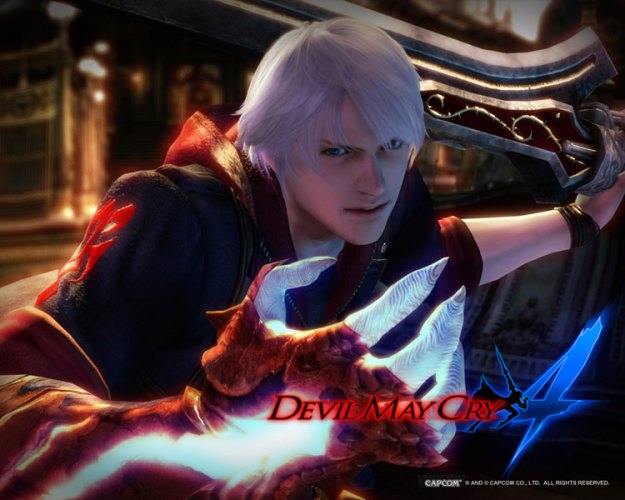
British developer Ninja Theory made the trek to Cologne, Germany for Gamescom 2011 to show off a very short tease of Capcom’s Devil May Cry prequel. The game will reboot the franchise with a brand new Dante, who has been completely redesigned as a younger, less refined hero. But his attitude has remained intact.
Rebel with a demon-smashing cause
The game retains the black humor that has been a staple of the third-person perspective action franchise, but it brings a more contemporary feel to the forefront. Tameem Antoniades, who’s official title is “Ninja Theory’s main creative dude,” used a Hollywood boxing reference to compare the new Dante to Raging Bull, rather than Rocky 3. He’s a disenfranchised youth, a rebel, and he has plenty of pent-up rage to unleash on demons and assorted creatures.
The new story, details of which have yet to be revealed, introduces an outcast Dante. Living on the periphery of society, Dante just doesn’t care. Fortunately, at least from a gameplay perspective, Dante has no fear and no respect for the demonic authorities that run the world he lives in. The new game introduces Limbo, a parallel universe controlled entirely by demonic forces. The gameplay experience in this world opens up new challenges through an interactive environment that’s always working against Dante’s quest. Passageways will close up, platforms will move, and demons will spawn from doorways. The action will occur in both the real world and in Limbo as the story unfolds.
Let there be light
The Gamescom game demo was set in a modern city that’s full of vibrant colors and light, which is a stark contrast to the dark, foreboding castles of past Devil May Cry games. The city retains the traditional Gothic elements that many European cities have, but gamers won’t have much time for sightseeing. Demons are everywhere. They literally spawn from the floor and walls.

The first thing gamers will notice in combat is that this rebellious young Dante is not the hero of old. He’s a more aggressive — and raw — fighter. Dante is equipped with new fighting skills to take out the assorted demons and monsters. While the traditional fighting mechanics of assorted melee and close-range weapons remains intact, there are more than just guns and swords at play now. Dante has a full range of airborne attacks, which are a great way to string together combos as enemies are hacked and slashed.
Combat evolved
Antoniades said the combat has the Devil May Cry feel, which will become more evident once gamers get their hands on the game (even press haven’t been able to touch the controller yet). One of the goals for the development team was to preserve the combat dynamics of the franchise, but add a new flavor to the mix. Gameplay encourages players to perform more aerial combat. Demons can be tossed in the air, where they remain for an inordinate amount of time as multi-chain attacks take them out.
Adding a new twist to the combat, as well as more depth to the experience, are the Angel and Devil modes. It’s here that Dante’s move set literally triples. By holding down the trigger button, Dante can make use of a new arsenal of powers categorized as either Angel or Devil. Devil powers introduce a grapple hook that can be fired at enemies. This maneuver plays in with the aforementioned aerial combat, opening up a tumult of combo-infused damage. The Angel powers will revolve around traversing the screen quickly, although this feature was not demonstrated. Each of these powers also opens up new weapons, with the Devil powers introducing two different sets of dual pistols and the Angel powers showcasing a scythe. Players can map these weapons to the D-pad for instant access in the heat of combat.

Capcom Japan and Ninja Theory insist that this latest game will offer the same addictive gameplay experience that fans the world over have come to love. Antoniades said the short game demo is only a small subset of the game’s combat. But he hopes it shows the developer has a handle on things. Motohiro Eshiro, the producer on the game at Capcom Japan, believes the new aerial combat, along with the Devil and Angel powers, adds something fresh to the franchise.
A hybrid approach
Ninja Theory is known for creating beautiful worlds and developing believable characters, while Capcom remains one of the best fighting-game developers in the world. The new Devil May Cry looks to marry these strengths, while introducing a new legion of fans to a different Dante and a more interactive and immersive world. The independent game studio is working collaboratively with Capcom Japan on this 2012 release.
To date, the development team has focused on creating fluid character control in building out this new world. How Dante and his enemies maneuver in combat has been the heart of this franchise from day one. As part of this effort, the new game will run at a fixed 30 frames per second (fps), rather than the previous games’ 60 fps. Antoniades said this allows the gameplay environments to be more complex with dynamic world changes, as Dante crosses between the real world and the demonic realm. The developer promises that by the time the game launches, it will still play like a Devil May Cry game.
The Xbox 360 and PlayStation 3 game is scheduled to ship in 2012. By then, the game should have a much-improved story line, which is a staple of Ninja Theory games. And as long as the gameplay retains the precision-based fighting action that has propelled the series to millions of units sold around the globe, fans who have questions the new look of Dante should be mollified.


